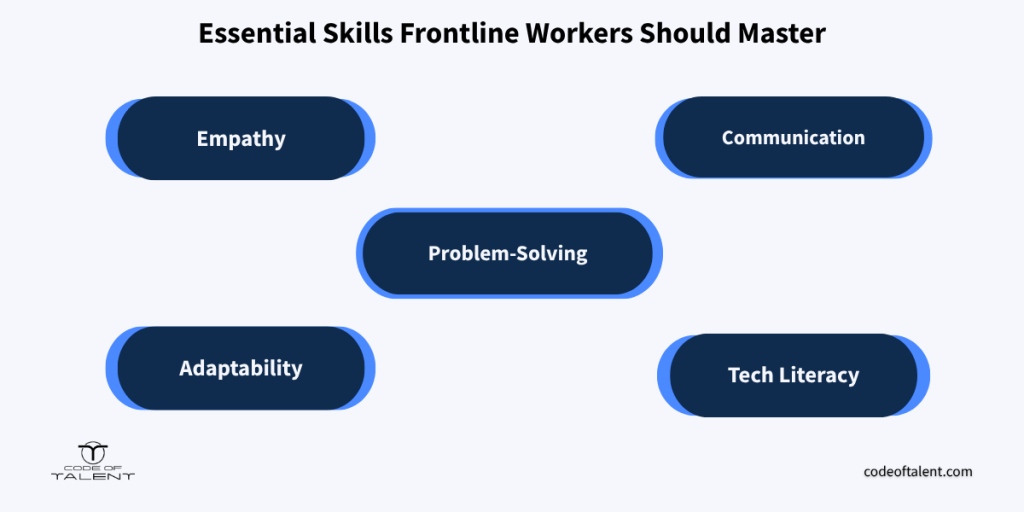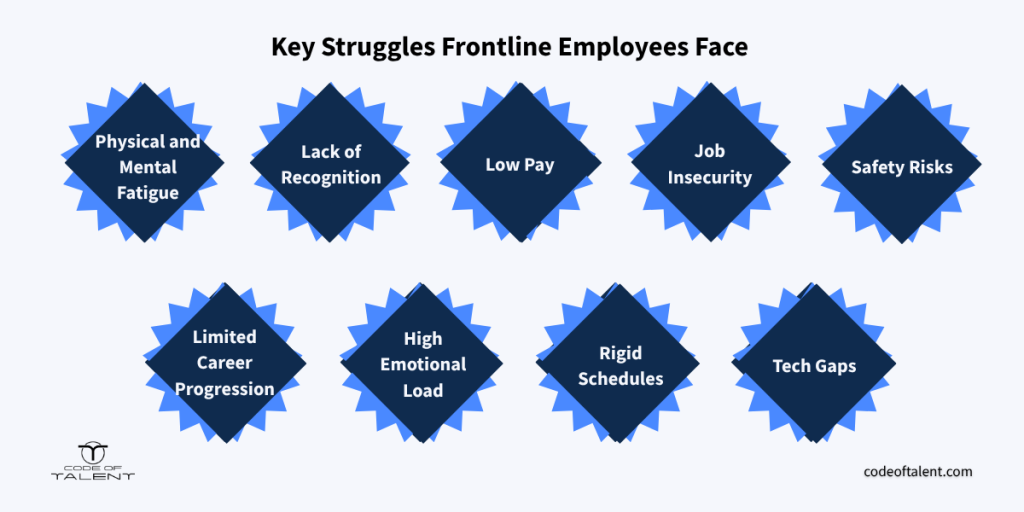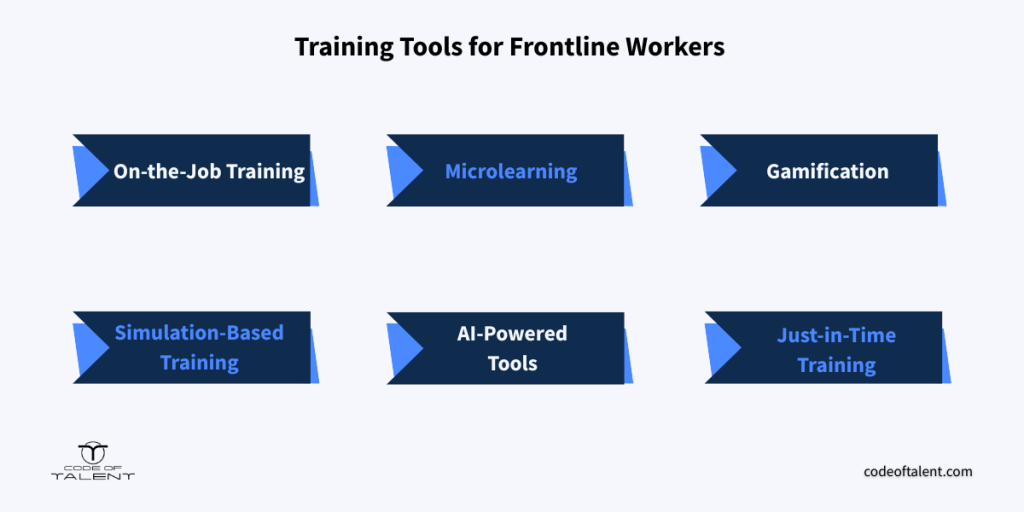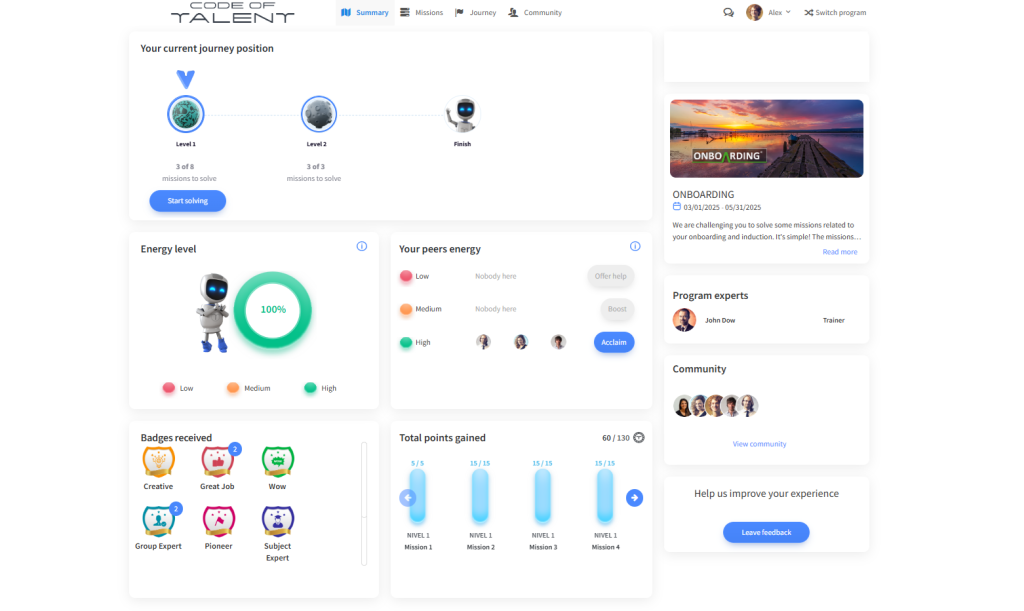Training is failing frontline employees. A study revealed that just 24% of frontline workers feel properly trained to do their jobs. That includes people in food service, retail, hospitality, and manufacturing. On top of that, 40% of workers said they weren’t even clear about what was expected of them in the first place. Training frontline workers the right way shouldn’t be an afterthought, but for many, it still is.

And while poor training isn’t the only challenge frontline teams face, it does make a tough job even harder. These workers are already under constant pressure: long shifts, difficult customers, and high-stress environments are just part of the deal. It’s no surprise that retail and hospitality have the highest quit rates in the U.S., surpassing the national average by more than 70%.
Here’s a guide to understanding what frontline workers really need and how to make training work for them.
Training Frontline Workers Strategy: The Who, The Why, The What, and The How
Too often, training strategies focus on business goals and overlook the people they’re meant to support. Frontline workers are the ones keeping things running, but their training is often rushed, outdated, or irrelevant.
Training frontline workers effectively means understanding who they are, why training matters, what kind of training actually helps, and how to deliver it in a way that fits their reality.
The Who: What Is a Frontline Employee?
Frontline employees are the face of any organization. They’re customer-facing or service-based workers who keep businesses operating daily. While their jobs vary, the demands they face are often the same: high pressure, fast pace, and little room for error.

Frontline Workers Per Industry
Frontline jobs vary across industries. Here is a comprehensive list of frontline job roles examples:
| Industry | Frontline Job Examples |
| Healthcare | Nurses, Paramedics, Medical Assistants, Lab Technicians, EMTs |
| Retail | Sales Associate, Cashier, Stock Clerk, Customer Service Rep., Store Manager |
| Hospitality | Hotel Housekeepers, Front Desk Clerks, Chefs, Servers, Bartenders |
| Logistics & Delivery | Delivery Drivers, Warehouse Workers, Forklift Operators, Package Handlers |
| Manufacturing | Machine Operators, Assembly Line Workers, Quality Inspectors |
| Public Safety | Police Officers, Firefighters, Security Guards, Correctional Officers |
| Transportation | Bus Drivers, Train Conductors, Mechanics, Flight Attendants |
| Education | Teachers, Teacher Aides, School Nurses, Custodians |
| Construction | Construction Laborers, Electricians, Plumbers, Site Supervisors |
| Food Service | Cooks, Line Cooks, Fast Food Workers |
| Cleaning & Maintenance | Janitors, Building Maintenance Workers, Sanitation Workers |
| Utilities | Electrical Lineworkers, Water Treatment Operators, Field Technicians |
| Banking | Teller, Personal Banker, Loan Officer, Customer Service Rep. |
Key Skills Every Frontline Worker Needs to Master

To succeed in customer-facing roles, frontline employees need a core set of practical skills that help them do their jobs with confidence and care:
- Clear, Professional Communication: Whether it’s talking to customers, coworkers, or managers, clear communication reduces confusion and avoids conflict. Still, 83% of leaders in retail and hospitality don’t feel confident in their staff’s ability to handle customer interactions, pointing to a clear opportunity for growth through better communication training.
- Adaptability: Workers need to stay flexible and adapt quickly to new policies, promotions, staff shortages, or unexpected customer issues.
- Tech Literacy: From POS systems and scheduling tools to mobile HR apps, knowing how to use digital tools makes day-to-day tasks faster.
- Problem-Solving: Being able to resolve problems quickly is a must for frontline employees who often deal with issues in real time.
- Time Management and Multitasking: Juggling multiple responsibilities during a busy shift requires strong time management.
- Empathy and Patience: Staying calm, kind, and understanding, especially in tough situations, is an essential skill in these industries that can be emotionally demanding.
Main Struggles for Frontline Employees

To succeed in customer-facing roles, frontline employees need a core set of practical skills that help them do their jobs with confidence and care:
- Clear, Professional Communication: Whether it’s talking to customers, coworkers, or managers, clear communication reduces confusion and avoids conflict. Still, 83% of leaders in retail and hospitality don’t feel confident in their staff’s ability to handle customer interactions, pointing to a clear opportunity for growth through better communication training.
- Adaptability: Workers need to stay flexible and adapt quickly to new policies, promotions, staff shortages, or unexpected customer issues.
- Tech Literacy: From POS systems and scheduling tools to mobile HR apps, knowing how to use digital tools makes day-to-day tasks faster.
- Problem-Solving: Being able to resolve problems quickly is a must for frontline employees who often deal with issues in real time.
- Time Management and Multitasking: Juggling multiple responsibilities during a busy shift requires strong time management.
- Empathy and Patience: Staying calm, kind, and understanding, especially in tough situations, is an essential skill in these industries that can be emotionally demanding.
Main Struggles for Frontline Employees
Being on the front lines means carrying the weight of fast-paced environments, demanding customers, and often, little support. Understanding their daily struggles is the first step to building training frontline workers correctly.
1. Physical and Mental Fatigue
Long hours and shift work can lead to exhaustion, while physically demanding tasks often cause strain or injury. Burnout is especially common in hospitals, warehouses, and fast-food kitchens, which leads to other issues such as turnover, costly mistakes, and disappointing customer service.
2. Lack of Recognition and Respect
Frontline workers are often overlooked or undervalued compared to office or leadership roles. Too often, these roles are seen as disposable by both the employers and the employees. Meanwhile, workers feel invisible to management and excluded from decisions.
3. Low Pay and Inadequate Benefits
Many frontline roles offer low wages and limited access to health care, paid time off, and other benefits despite being essential. There are also few opportunities for financial growth or advancement.
4. Job Insecurity
Many frontline roles are part-time or gig-based, which means fewer protections and less long-term stability. Workers in these positions are often the first to face layoffs during economic downturns or shifts in business strategy. And without clear paths to advancement or consistent hours, it’s hard to feel secure in the role.
5. Safety Risks
Safety risks are another major concern for frontline workers, especially in physically demanding or hazardous environments like construction sites, factories, or during public health crises. Many are exposed to health hazards without the proper training or equipment.
A YouGov survey of over 2,000 frontline workers across Australia, the UK, and the US found that 64% believed better training could have prevented injuries they experienced or witnessed. Even more concerning, only 25% said they received valuable training from their employers in the past year.
6. Limited Career Progression
Many frontline workers feel stuck. Professional development opportunities are often limited, and access to mentorship or upskilling tools is rare. Without clear paths to grow into management or office-based roles, it’s easy to feel like the job is a dead end instead of a stepping stone.
7. High Emotional Load
Interacting with the public all day comes with emotional strain. From handling complaints to dealing with emergencies, the constant demand to stay calm and professional takes a toll. Over time, this pressure can lead to burnout, especially when there’s little support in place.
8. Rigid Schedules
Frontline work rarely offers flexibility. Shift work and fixed schedules make it tough to balance jobs with parenting, school, or personal health. Time off can be hard to come by, and last-minute schedule changes don’t help.
9. Technology Gaps
Frontline workers often struggle to keep up with new technology. Tools and systems change quickly, but many don’t get the training or support they need to use them. And with so many technology options comes overload. In fact, productivity has dropped by 40% as employees waste time switching between apps, searching for information, and trying to manage systems that don’t work well together.
The Why: Why Frontline Worker Training is Essential
Training frontline workers is a real investment in people who keep a business running every day. Here’s why effective training matters so much:
Builds Confidence and Job Satisfaction
Training after all means improving skills and changing behaviors. Upskilling not only provides opportunities for employees to grow professionally and personally, but also adds up to their overall job satisfaction.
In a recent survey, a significant 71% of workers said that learning new skills made them feel more satisfied with their jobs. Amazon has also estimated that aside from job quality, upskilling improves annual wages by 8.6%.
Speeds Up Onboarding
Well-designed training helps new hires understand their job role and company culture much faster, speeding up the onboarding process. Instead of learning through trial and error, strategic onboarding programs shorten the time it takes for employees to become productive contributors (or time to productivity).
This also improves turnover rates in high-pacing environments.
Improves Customer Service
When frontline workers are trained to handle customer interactions effectively, the result is better service, fewer complaints, and more loyal customers. For example, a 2023 Gartner study found that service interactions can significantly improve customer loyalty.
Prevents Injuries and Costly Safety Mistakes
Most frontline jobs come with a higher risk of injury, safety mistakes, or hygiene issues. The work is physically demanding, and employees often deal with the public, heavy equipment, or hazardous materials, all of which raise the stakes when safety training is lacking.
Apart from the toll on workers and customers, workplace injuries are also a significant financial burden. In 2023, the total cost of work-related injuries in the U.S. reached $176.5 billion, including wage and productivity losses, medical expenses, and administrative costs.
Proper training reduces workplace injuries as employees understand safety protocols and how to use equipment correctly.
Supports Career Growth and Long-Term Success
Training is about tomorrow’s opportunities. When employees see a path forward, they’re more likely to stay and grow with the company. Take Gen Z, for example: over half are interested in careers in hospitality and other frontline roles. They’re eager to develop, and the right training can help them do it.
Additionally, as Forbes reports, companies like Walmart show that this investment works: many of their store managers started out as hourly associates and rose through the ranks.
The What: Modern Training That Works

One-size-fits-all doesn’t apply anymore to training frontline workers. Modern training methods are flexible, practical, and, most importantly, built around real-world needs that frontline employees have.
Here are the key types and features of training that make a difference:
1. On-the-Job Training
What It Does: Frontline workers are always on the move, so that’s why 91% of them prefer mobile access to training materials. Mobile-friendly, on-the-job learning fits into their workflow, allowing them to access lessons during breaks or while actively working. This approach saves time, reduces fatigue, and makes training part of their day, not a disruption to it.
Example: A grocery store clerk accesses training videos and schedules through their phone during breaks, without needing to be at a desk.
2. Microlearning
What It Does: Information overload is a major problem for frontline training. In fact, 83% of employees in retail, food service, and hospitality report feeling overwhelmed by the volume of information needed to do their jobs well. Microlearning is an efficient solution to that as it delivers short, digestible lessons (no more than 10 minutes) with the right amount of information, fitting into even the busiest schedules.
Example: A delivery driver watches a 5-minute video on safe loading techniques during a quick break, fitting training into their tight schedule.
3. Gamification
What It Does: Adding elements like badges, points, leaderboards, or journey maps makes learning more engaging and even fun. Gamification encourages participation, rewards progress, and helps with knowledge retention. Plus, it taps into workers’ natural competitiveness, motivation to do well, and be recognized.
Example: Warehouse workers earn points and badges for completing safety quizzes, turning a rather tedious learning session into an entertaining experience.
Caption: User interface of microlearning platform Code of Talent, with gamification features such as energy level, journey position, and leaderboards.

4. Simulation-Based Training
What It Does: Simulations create safe spaces to practice customer interactions, handle tricky situations, or respond to emergencies. Employees work on their confidence and problem-solving skills in a low-risk environment before taking on the real thing. Additionally, simulation training improves empathy and emotional intelligence as it encourages learners to see things from others’ perspectives.
Example: Health care employees use role-play simulations to practice handling difficult patient interactions, like delivering bad news or discussing sensitive, personal topics.
5. Just-in-Time Training
What It Does: Thanks to technology, training information can now be updated in real time. When policies change or new tools roll out, frontline workers need fast, relevant updates. Just-in-time training delivers the right information at the right moment, helping employees stay up to date without needing full retraining sessions.
Example: A restaurant server receives a quick mobile alert about a menu change, with a short video explaining new dishes, just before their shift starts.
6. AI-Powered Learning Tools
What It Does: Despite the benefits, 84% of organizations still don’t use AI-enabled training for their frontline teams, largely because they lack the expertise to implement it. But platforms powered by AI can deliver personalized content, track progress in real time, identify skills gaps, and break down huge amounts of information into accessible learning modules. Automation also helps in setting aside time-consuming training tasks and concentrating on what’s important: strategizing and optimizing.
Example: Telecommunications workers use AI-powered training platforms that break down complex materials and procedures into easy-to-understand lessons.
The How: Best Practices for Designing Great Training Programs
Having the right tools is one thing, using them well is another. To make training stick, companies need a clear plan that keeps workers in mind every step of the way.
1. Define What Success Looks Like
Start by setting clear KPIs (key performance indicators) and metrics that help you measure the impact of training.
- Are workers more productive?
- Are customer satisfaction scores improving?
- Are safety incidents going down?
If you’re not tracking it, you can’t improve it.
2. Set SMART Goals
Your training goals should be:
- Specific
- Measurable
- Achievable
- Relevant
- Time-bound
Instead of saying “improve customer service,” say “reduce customer complaints by 15% over the next 3 months by offering soft skills training at least one time per week.”
3. Ask for Feedback and Actually Apply It
No one knows what’s working (or not) better than the people actually doing the job. Make it easy for workers to share their thoughts on training through surveys, quick check-ins, or open forums.
Afterwards, it’s important to apply that feedback, as it shows workers that their voices matter. Tweak your training based on what they say, and keep them in the loop about changes being made.
4. Measure and Adapt
Don’t set your training strategy and forget it. Regularly look at the outcomes and adjust what isn’t working or use more of what’s working. Just like any other process, a training strategy is a trial and fail journey, a living thing that should evolve with the workforce.
5. Use One Platform to Keep Things Simple
Frontline workers don’t have time to bounce between apps or dig through emails to find what they need. A centralized training platform keeps everything in one place: onboarding, compliance, upskilling, and feedback, easy to access and easier to stick with.
Training Frontline Workers with One Platform
Frontline teams, especially in customer-facing roles, need training that’s fast, relevant, and easy to access. That’s where Code of Talent comes in. Our platform is designed specifically to meet the challenges of training frontline workers by keeping it simple, smart, and scalable.
Here’s how Code of Talent addresses the key training needs:
- One central hub for training: Consolidate onboarding, microlearning, compliance, and upskilling into one mobile-friendly platform.
- Microlearning for busy schedules: Bite-sized lessons fit into frontline workflows without overwhelming staff.
- Simulation-based and gamified learning: Make training interactive and fun.
- AI-powered experience: Break down complex procedures into role-relevant steps.
- Feedback and progress tracking: Easily collect feedback, track performance, and adjust training strategies based on what’s actually working.
- Mobile-first design: Train on the go, anytime, anywhere. Perfect for non-desk roles in retail, hospitality, banking, and more.
Trusted by Leading Frontline Brands
From Vodafone and retailer Penny to pharma leader Zentiva and top commercial banks, major frontline employers trust Code of Talent to deliver scalable, efficient, and impactful training. Our success with these companies include:
- Time to productivity reduced by 50%
- Skills improved by 70%
- Visibility and control rates at 100% at all times
- Above 90% completion rates for training programs
Check out our success story with beverage giant Coca-Cola in improving their sales team’s efficiency and productivity here.
Frontline Workers Training Done Right
Training frontline workers shouldn’t be a struggle with today’s technologies and modern techniques. See how easy it is to do so by trying Code of Talent’s free trial. Build your own training program from scratch based on your business needs and offer the best support for your frontline workers now!
Cover photo: Freepik





